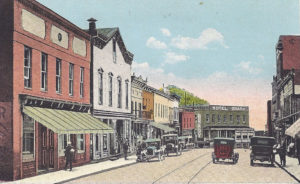
Lonaconing in the early 1900s. Photo courtesy of the Albert and Angela Feldstein Collection.
It was a summer for Lonaconing in 1881. Even with the changing of the months from August to September and cooling temperatures, it hadn’t rained for four weeks.
P.T. Tully and Co.’s store was on the east side of Main Street. On Sept. 7, Mr. Hanlon, one of the store’s employees, was sitting down to a lunch with his family that would never be finished because a fire broke out in the stable behind the store.
The fire found fertile ground among the blowing wind, dry conditions and wooden structure. It moved to the store and then the flames began sweeping north along Main Street until there were no more buildings to consume and south to Bridge Street. The last building to burn was the Merchants’ Hotel, kept by William Atkinson, who also kept a store adjoining the hotel.
With no fire department, people rushed to and fro with buckets of water trying to put out the fire and stop its progress. However, the dry conditions meant that water levels were extremely low. Calls for help went out and the Westernport Fire Department was the first on the scene within an hour.
“Fifty-three buildings went up in smoke in three hours. Overcome by panic, men broke open whiskey barrels and lay intoxicated in the street while the Westernport Fire Department put out the blaze,” John Wiseman wrote in Allegany County–A History.
A Cumberland steamer arrived to help with the firefighting efforts, but the pump wouldn’t work “and the Cumberland firemen, who were willing and anxious to do anything in their power, were obliged to return home after a short stay on the scene,” John Thomas Scharf wrote in A History of Western Maryland, Vol. II.
“Had there been an engine of any kind in Lonaconing at the breaking out of the fire, much valuable property could have been saved. Fortunately, the principal loss fell upon those who were able to rebuild, although many lost everything,” Scharf added.
Among the buildings burned were D. R. Sloan & Company, Rechabite Hall, the German Lutheran church and parsonage, Dixon’s Hotel (on Main Street), the Merchants’ and Brady’s Hotels (on Bridge Street), and Joseph Meyers’ row of buildings on Bridge Street.
Firefighters were not without injury. James Carrigan, a tailor from Baltimore, located in Frostburg, had his arm cut off in jumping from the special train containing the Cumberland engine when it arrived at Lonaconing. David Dickson was badly burned from running through flames in order to save his own life. A falling joist burned James Hohing’s wrist. Edward Lewis of Frostburg had his arm and neck burned. Robert Sommerville of Barton sprained his foot.
Men were put out of business and families left homeless in what was the biggest fire in the county in nearly half a century. The total loss covered 10 acres and was estimated at $150,000 and less than half of that amount was covered by insurance.
“Had the fire broken out at night there would have been a terrible loss of life, so rapidly did the wooden structures, which were built very close to each other, burn,” Scharf wrote.
Despite the devastation of the fire, citizens rallied together and learned from their mistakes.
“In the long run, however, the Lonaconing fire was a blessing. Before the calamity the main street was a six-inch slough of mud for half the year, the long steps of houses ran to the streets, and there were no sidewalks. A year later the town organized a volunteer fire department, and a new sense of public-spiritedness, rekindled by a devastating flood in 1884, would lead to Lonaconing’s incorporation in 1890, paved streets, and modern architectural touches,” Wiseman wrote.
As a result, the Lonaconing Fire Company was organized in April 1882 with a hand pumper named “Minnehaha” and several hose reels serving as the first fire apparatus. In 1883, the first station was built, and in 1906, the organization changed its name to Good Will Fire Company No. 1.
You might also enjoy these posts:
One Reply to “Lonaconing, Md., was a phoenix rising from ashes of a devastating fire”
Comments are closed.